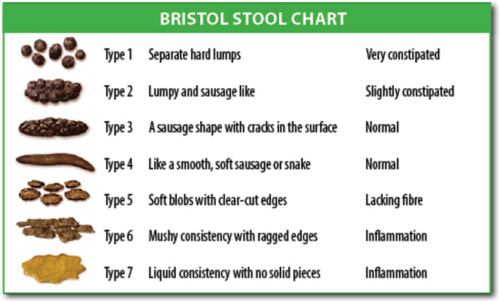The Bristol Stool Chart or Bristol Stool Scale is a medical aid designed to classify the form of human faeces into categories.
Sometimes referred to as the "Meyers Scale", it was developed by Dr. Ken Heaton at the University of Bristol and was first published in the Scandinavian Journal of Gastroenterology in 1997. The form of the stool depends largely on the time it spends in the colon (though there may be other contributing factors, including diet and illness).
The seven types of stool are:
1: Separate hard lumps, like nuts (hard to pass)
2: Sausage-shaped, but lumpy
3: Like a sausage but with cracks on its surface
4: Like a sausage or snake, smooth and soft
5: Soft blobs with clear cut edges (passed easily)
6: Fluffy pieces with ragged edges, a mushy stool
7: Watery, no solid pieces. Entirely liquid
Types 1 and 2 indicate constipation, with 3 and 4 being the "ideal stools" especially the latter, as they are the easiest to defecate, and 5–7 tending towards diarrhoea.

I like your post ,now I must complete my research for my paper.
ReplyDeleteFinance Dissertation